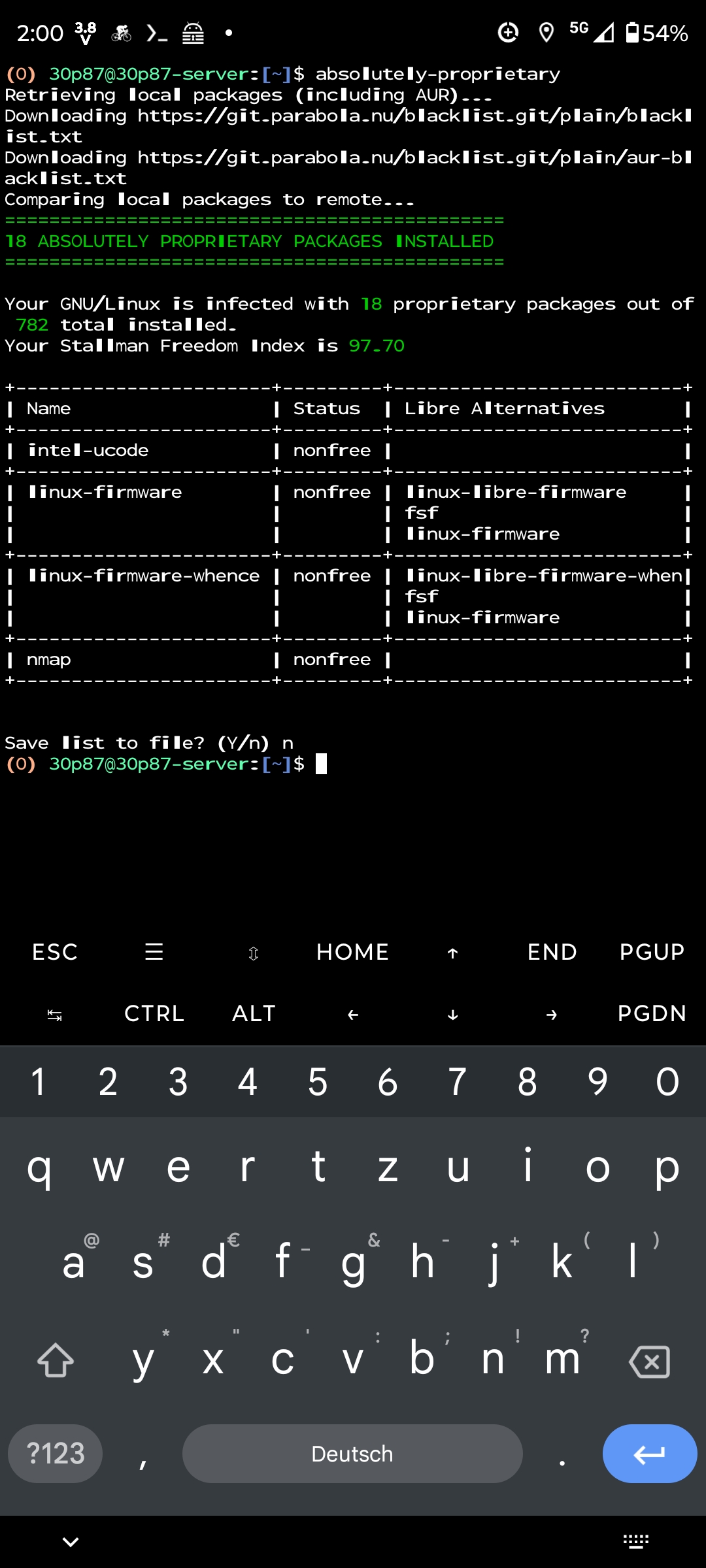Removed by mod
I use a LibreCMC router too, I love it! I have an OpenWRT network switch (VLAN support) with 100% free software in the OS layer; I believe some firmware blobs were removed as well. I have OpenBSD on all my systems and run Whonix VMs in vmm. All my hardware has Libreboot with IME fully removed, 100% blobless in the BIOS. I didn’t update my EC or microcode. I strictly use free software and removed anything proprietary, including non-free firmware packages. All system updates get routed through Tor. I don’t use a dedicated GPU since I don’t play video games anymore. I truly learned to value freedom over entertainment. Learning coding has been my main thing since I got rid of everything proprietary, and let me tell It feels super empowering.
Removed by mod
Id say around 80% since I use a lot of foss programs and only use linux/android/openwrt/brother printers. The other 20% is random proprietary stuff like steam I guess to be generous.
1 FreeBSD server with zfs mirror for storage and various server software
1 FreeBSD laptop for development
1 Linux laptop for software that doesn’t support FreeBSD
1 Linux desktop for work.
The rest of the family is 100% windows though :/
Like sub 10% maybe.
Phone 1: iPhone
Phone 2: Android (pixel 4, stock rom)
Desktop 1: Windows
Desktop 2: Mac OS
Laptop 1: Windows
Laptop 2: Mac OS.
Laptop 3: Windows/KDE Neon, no attention paid to whether or not the drivers are foss.
Server: Proxmox with Debian and Truenas VMs.
Router: pfSense.
I just use what works for me, and what license the software uses is not at all a factor in that choice.
Is there a reason to us pfsense insteaof opnsense?
No.
Currently running majority FLOSS, and glad for the excellent options that these very capable people have released.
Desktops, laptops, HTPC:
Trisquel GNU/Linux on Libreboot BIOS hardware
–//–
Phones and tablets are:
GrapheneOS + Fdroid only apps
–//–
Rockbox audio players
(+ Open Tunes from FMA, Argofox, CC netlabels, jamendo, bandcamp etc)
–//–
Gadgetbridge + Amazfit Bip (watch)
[Looking to switch out this watch for a FLOSS smartwatch like: pinetime or bangle.js]
–//–
and dd-wrt on the router
OpenWRT is going to be better than DD-WRT. It is certainly more flexible
Thanks, I was checking both before going with ddwrt.
Looks like OpenWRT has more options and less hand-holding. Would that be right?
Yes but the wiki is very solid. Also the basic functionality doesn’t require much to setup. Just make sure you set the WiFi country
This guy has mad FOSS cred. I bet even his socks are made of free range organic open source wool released under a Creative Commons attribution share-alike licence.
Seriously though, that sounds like an amazing setup. I always wanted to mess with gadget bridge some more. I have a number of old MiBand devices lying around as well as a Bip. The third party apps for that thing had more features than almost every fitness tracker I’ve had potentially even including my Garmin watch. What tools do you use to analyze/review/visualize the gadget bridge data?
Thanks for the props :]
I usually look at the session graph data on Gadgetbridge, or export a bike GPS track to OSMand to look more in depth at position, height, speed etc.
aside from my kernel not very much
Libreboot + GNU/Linux-Libre Guix System
Please, more details
Irony? Hahah
No I genuinely want to know
Well for libreboot i had to program the bios eprom (SOIC-8 SPI programable). For that i used a chinese CH341a programmer which didn’t work (IMPORTANT: first i had to fix the chinese design hardware problem that the ch341a has were it uses 3.3v as vdd but 5v as high level for digital spi signals) because of the shitty cables of the kit. I tried with a rpi pico with the same cables and also didn’t work. Then i literally knitted cables one by one in each of the eprom pins in order to program it and it worked. My advice: don’t use cheap chinese SOIC clips/cables. The CH341a can be fixed but if you can, also don’t use it. They have a bug in their hardware design and they don’t fix it.
After that i just installed Guix system iso in a pen and proceeded with the installation. I did a full encryption install (FULL all /boot included) because with libreboot you can have grub in your eeprom which is awesome. So basically i have a permanent bootloader that launches at start (besides all the other stuff libreboot does about neutering intel management engine, etc)
Then i followed more or less this in order to create the config file of the system. Once the config file is created you gust run guix and it does everything: configuration, compiling software if needed, etc.
And basically that’s it. Well i also searched for a pci wifi card that had free software drivers in h-node.
Libreboot is very cool. You can change bios “variables”, like for example modifiying your laptop hardcoded company MAC address for a random one (which I did). You have to do that when you are compiling the image that you will write into the eeprom.
Ah and btw Linux-Libre is just the default kernel for guix system. Basically 0 bloat. There are people channels that have guix system with bloat, but Guix by default is bloat free (well in reality only if you install libreboot too like i did :) ). That’s why i bought a libre software compatible wifi card.
But Guix system can also be build with Linux, systemd ( the initd is shepherd) and other stuff if you configure it like so. But in order to do that you will have to read the Guix manual probably.
Basically a hobby project. I wanted to have a fully free computer. So i bought a x220 on ebay and did all that to have the fully free laptop.
Guix can be used as a kind of package manager in any other distro. And it has super cool features. It’s worth checking out just for that. It follows the classical GNU filosofy of “hack with your computer as much and deeper as you want”.
Guix system is perfect if you want to mess around, because you can just revert back in time your whole system.
Saved
Ages ago someone wrote a bash script that would calculate your “stallman score”, essentially checking the license of every package in your system.
Well, we need that back!
It’s called vrms (virtual RMS) and Debian at least packages it.
7 out of 705 installed packages are non-free packages on my RPi server.
It’s called check-dfsg-status since Stallmann stepped down after his controversial statements in Minsky’s Epstein scandal.
TIL
😮

absolutely-proprietary?
nmap isn’t Foss?!?
From absolutely-proprietary:
“the FSF considers the v7.9x license to be non-free - however, the previous license was apparently non-free also”That’s all I know
Nearly 100%. All Linux and AMD. The biggest part that isn’t is BIOS. As far as programs go I can think of almost nothing I use that isn’t FOSS. I guess Discord.
Arch on every box in the house, including the primary router. Mixed Intel and AMD. Openwrt on every AP (unfortunately Mellanox and MediaTek firmware blobs for the radios). GrapheneOS on my daily and LineageOS on my legacy phone.
Aside from occasional games, I don’t install anything I don’t have the source to. My phone is the only exception, for apps required to interface with the rest of the world.
What is your “legacy phone”?
Ah, my last phone that no longer receives any updates. Pixel 2XL. Just keeping it around because parting with electronics is difficult.
Linux on all my computers and GrapheneOS on my Google Pixel 6a with 99.8% FOSS applications. Maybe 96% FOSS softwares on my stationary computer and 100% on my laptops.
With GrapheneOS do you still get the same quality photos as you would with the stock OS?
I use Open Camera and the quality is very good. Especially the night mode! What you see with your eyes in a dark room with the TV on, that’s what you will see in the photo. Not the same quality on the TV in the photo, of course, but very close.
Just a +1 for Open Camera - it’s a great bit of software.
95% paypal, linguee and banking apps
As much as I can get it, and more every year.
All my computers run Linux exclusively. Gaming desktop, personal laptop, Steam Deck, work laptop, and all my servers in my home lab.
Hypervisor is XCP-ng, VMs are a mix of Ubuntu, Debian, Fedora, and some random other Linux distros for testing and experimenting.
My NAS is a TrueNAS Core box.
I’m in the process of switching my router to PFSense.
Phone is a Pixel 6a with GrapheneOS.
Email, VPN, and cloud storage is Proton.
Password manager is Bit Warden.
Office docs are all Libre Office & Only Office.
The only non-FOSS software I use constantly is Discord and Steam, and of course, most of the games I play. On my phone I have majority FOSS apps for everyday stuff, but some things are still proprietary.
Seems you also use a bit of freeBSD in your setup besides Linux. Still FOSS though!
What are you recommendation of decent NAS with freeBSD?
I have no such advice. I use a Linux basedd NAS myself.
What NAS do you use?
Debian-based custom built thing. Nothing special.
Mostly
I still have Intel WiFi and a phone which requires firmware to work correctly.
I also recently installed Lego star wars in Bottles for fun. I also use the web a lot which uses non free JavaScript.
😮😮 JS is non-free?
The engine probably is free, but the code it runs often is not.
isnt all JS technically code-available though?
so at least we have that going for it.
Even then, it might be minified or even obfuscated
You can’t run, study, modify and distribute it
It’s hella foss!









